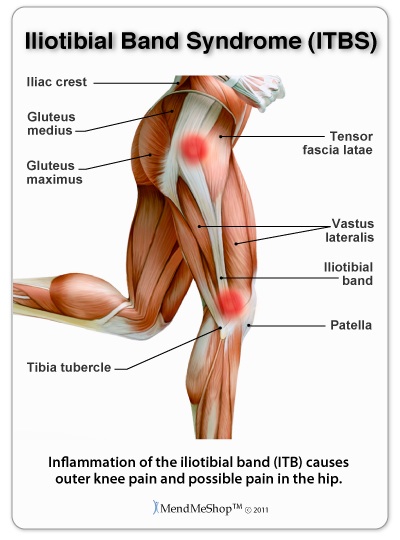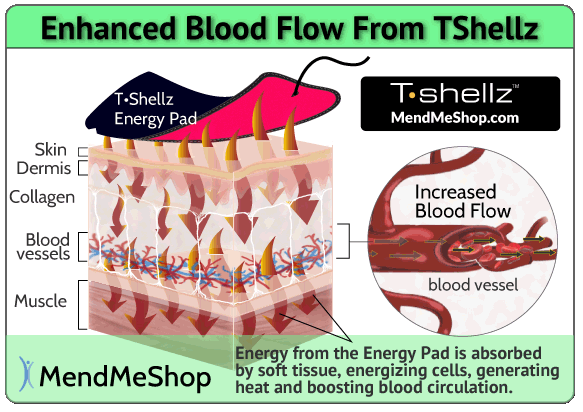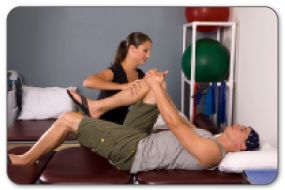Iliotibial band syndrome (ITBS) is a common condition in athletes, especially runners and cyclists, and occurs when the IT band becomes irritated, inflamed and tight. The IT band (also called the iliotibial band or iliotibilal tract) is a thick, fibrous tendon that runs along the outside of each leg. These bands run from the iliac (crest of the pelvis), over the greater trochanter at the side of the hip, down the leg, and inserts on the outside of the knee at the top of the tibia (tibial tubercle). Each IT band works with the thigh muscles during flexion and extension of the knee to slow you down when running and helps provide stability to the knee joints.

Excessive rubbing of the IT band over the tibial tubercle (bony prominence at the outside of the knee) is a common cause of the irritation that leads to inflammation, tightness and pain. Although the pain from ITBS usuallly occurs at the outside of the knee, soreness in the hip may also occur. Pain in the hip is usually caused by the IT band tightening and rubbing over the greater trochanter, the outer hip bone.
The initial pain of ITBS is caused by the tightening, irritation, and inflammation in the IT band. As the IT band starts to heal, scar tissue begins to develop on the iliotibial tract. This scar tissue is tough and inflexible and it stops the muscles attached to the IT band from moving smoothly. This causes further pain at the knee and tightness is usually felt in the hip and down the leg to the knee.
Symptoms of ITBS in runners usually begin with pain developing during a run which subsides shortly after the run finishes. Pain continues to appear with every run eventually progressing to more constant pain while walking or going up or down stairs. Typical symptoms experienced are:
The risk of a person contracting iliotibial band syndrome can increase with any condition or activity that may cause excessive rubbing of the IT band, such as:

Your doctor will do a physical examination which may include range of motion tests. He or she may arrange x-rays and/or an MRI. An x-ray will rule out calcification or bone spurs in the area. An MRI can identify the inflammation or damaged IT band. It can also determine if there is any other damage in the soft tissue neighbouring the iliotibial tract.
Initial treatment of iliotibial band syndrome should focus on resting your leg and reducing the inflammation to help relieve pain. Do not train through the pain. It may be necessary to stop training for a week or two.
Treating your iliotibial tract with cold compression and Circulation Boost will reduce the pain and inflammation so you can get back to training sooner. However, once the pain is gone it does not mean you are healed. Absence of pain generally means the swelling and inflammation is gone, but it takes quite a while for the underlying injury to heal. This is why you get flare ups after you start getting active again (once the pain is gone) - you are still injured and must heal the injury completely!
When your IT band becomes inflamed and sore during a run, doctors recommend immediate treatment with cold. Cold compression is the safe and natural way to control pain and swelling while minimizing tissue damage. Frequent, cold treatments within the first 72 hours of the iliotibial tendon becoming inflamed is an effective way to relieve pain and swelling while limiting the amount of damage done to your tissue. In addition, cold can reduce, or even eliminate, the need for NSAIDs (non-steroidal anti-inflammatory drugs) that can be harmful to your body.
Cold compression works by interrupting and slowing nerve and tissue function in the injured area and reducing swelling that can block blood vessels. This is important because once blood vessels are blocked or damaged, they can no longer carry oxygen and nutrients to your iliotibial tract and tissue begins to break-down. Without cold, tissue break-down and damage continues because tissues do not get the oxygen they need to survive.
When you stop moving your hip because it hurts the amount of blood that flows naturally to your acetabular joint is reduced, limiting your body's natural ability to heal itself. This why massage, PT and stretches are all considered important in rehab - they are all designed to (1) induce more blood flow to the injury area so you can heal faster, and (2) keep your soft tissue (muscles,ligaments,tendons) stretched and flexible to help prevent atrophy.

Once the inflammation in your IT band has been reduced with cold it is time to take the next step in your IT band treatment. Use a Back/Hip TShellz Wrap® to improve blood flow while simultaneously helping surrounding soft tissue to become elongated and more elastic. What this means is that not only is increased blood flow helping the iliotibial tendon and surrounding soft tissue to heal, the tendons/muscles/ligaments are now longer and more elastic due to the heat effect of the treatment. It is the most natural way to speed healing of your damaged iliotibial tendon and surrounding tissue while reducing the risk of atrophy (weakening of the muscles) in your upper leg muscles and hips. The TShellz Wrap® is a perfect tool to use at home to help augment your massage and PT sessions to help keep your blood moving.
TShellz Wraps® are basically the perfect home treatment for IT Band Syndrome - helping improve elasticity and length of the tight tendon while healing at the same time!
Improved blood flow helps reduce the risk of atrophy in muscles. When you stop moving your leg and hip due to pain, your muscles and other tissue can become weaker and dead tissue and toxins in the area can cause further tissue deterioration - this can lead to atrophy in your quadriceps, hamstrings, glutes and many other muscles in the thigh, groin, lower back, knee and hip. The Back/Hip TShellz Wrap® is an amazing healing tool that can be used to treat your entire core area. We have TShellz Wraps® for every major joint of the body.
By clearing the area of toxins and increasing the amount of oxygen and nutrients to your hip, IT band, and leg muscles, the risk of atrophy (muscle weakness and/or deterioration) is greatly reduced. Keeping your hip and leg tissue as healthy as possible throughout the healing process will allow you to improve strength again once your pain has gone and your IT band has healed.
HEAT (warmth) is used after you've reduced your swelling / inflammation and the sharp pain is less intense (you have more of a dull / nagging ache and soft tissue tightness in your hip). Warming up soft tissue using a TShellz Wrap® is a natural way to encourage healing of bursitis and surrounding soft tissue. Increasing the temperature of soft tissue results in increased blood flow circulation as the body sends more blood to attempt to remove this same heat. It's the blood in your body that will bring oxygen, nutrients and water (basically energy) to your injured hip to help with healing.

When heat is applied to tissue in the hip, veins will start to get bigger (expand) to allow more blood flow through to your damaged or torn soft tissue. This in turn relaxes your hip, making the tissue more flexible and elastic. This is why heat is used on older (chronic) injuries, to loosen tissue and bring in the blood flow needed for healing. Your body will begin to heal itself after it is injured - but it needs a good strong blood flow to do this.
Doctors usually call this process 'Vasodilation'.
Heat can Make Inflammation, Swelling and Newer Injuries Worse - How?
When we injure ourselves, we start healing right away. The body will naturally raise the temperature at the site of the injury resulting in the inflammatory response (redness, heat sensation, inflammation and swelling). This 'fake fever' leaks blood flow to the area to cool it down and start the healing process.
Adding 'heat' to your hip when it's already inflamed and tender may make your body think there's a new threat to your tissue and increase the pain in order to get you to stop. For some people applying heat on inflamed / swollen tissue will cause the injury to swell-up even more (as much as 3 times larger than normal). You'll feel even more pain as the pressure builds in your hip.
Heat is NOT a good treatment method for inflamed soft tissue, new injuries (within the first 24 to 72 hours), right after surgery or right after a re-injury (over-use and/or sharp, throbbing pain). In these cases, heat should be applied later on in the healing cycle. In the meantime, use a Cold Compress or Ice Pack to decrease any inflammation induced pain.
A TShellz Wrap® temperature treatment works best to increase blood flow circulation and stimulate healing for older (chronic) injuries, re-injury (after swelling has been reduced) and during long-term post surgery recovery. Warmer temperatures should be used approximately 3 to 5 days after you first have the injury. Heat should not be started for a least 2 weeks after surgery because inflammation levels will be very high as the healing process starts over again. Any use of heat should also be combined with gradual movement to stretch out your hip and increase range of motion.
If you have a chronic hip injury that keeps getting re-injured you should use heat before activity to loosen up your tissue (making it more flexible). When used at this time the warm temperatures naturally extend the elasticity (elastic-nature) of the joint, making it more movable / pliable for activity.
Sometimes we feel pain while doing a certain activity - should you still use heat? Using heat in the morning before you start your day or before activity can help to boost the healing process and reduce your risk of re-injury. Too much heat (especially when you suffer a set-back with swelling / inflammation) can make your inflammation worse. Cold treatments with a Cold Compress or Ice Pack should be used part-way through your day when you suffer from on-going pain and inflammation as a natural pain-reliever.
Keep using Circulation Boost before activity and when you notice any stiffness in your hip to 'warm up' your muscles, tendons & ligaments - and stimulate healing.
Click HERE to Go To Our Online Store We take all major credit cards and Paypal.
If you have questions, call our office at 1-866-237-9608 (toll free continental US).
We are currently offering FREE SHIPPING and a 60 day trial period on all our Wraps.
NSAIDs, non-steroidal anti-inflammatory drugs, can be used if required to help manage your pain. However, these aren't recommended for long term use, as they can cause gastrointestinal difficulties and increase the risk of cardiovascular disease. The TShellz Wrap®, when used in conjunction with NSAIDs can greatly improve the effect of the medication; this can not only help you heal quickly but also reduce the amount of NSAIDs that you ultimately may require.
PT (PT) is a beneficial way to restore atrophied muscles and improve strength and mobility when suffering through a long term debilitating hip injury. The type of PT and the duration will be dependent on the tissue damage and your symptoms. When you are treating or recovering from IT Band syndrome, it is important to ensure you do not perform any exercises that will further irritate the condition.

Once your pain starts to diminish, a physiotherapist will set up an individualized strengthening and stretching exercise program for you to perform at home or in the gym. This will be based on your needs and abilities, and will help you return to performing your normal routines.
Individuals will often lift weights on their own, to try and build up their strength. However, in doing so, they can do more damage to their joint. It is extremely important to strengthen your muscles properly, as they may have weakened during the period of non-use. A trained therapist will help to ensure your rehabilitation process is appropriate and effective. For best, long term results use TShellz Wraps® at home, in conjunction with PT and an exercise program.
Click HERE to Go To Our Online Store We take all major credit cards and Paypal.
If you have questions, call our office at 1-866-237-9608 (toll free continental US).
We are currently offering FREE SHIPPING and a 60 day trial period on all our Wraps.
We've helped thousands of people treat their painful injuries and conditions to get them back on the road to a pain-free life!
Our customer service lines are open 5 days a week helping people understand their injuries and how to treat them. Simply call toll free 1-866-237-9608 to talk or place an order with one of our knowledgeable Product Advisers. They have the ability to answer questions and even put together a treatment plan for you.
AidYourHamstring advisors do not work on commission, so be assured you will only receive fair and objective information.
Product Advisors are available 9:00 am to 5:00 pm Eastern Standard Time Monday to Friday.
I want to learn more about Surgery & Post-Surgery Recovery
I want to learn more about Circulation Boost
I want to learn more about Ice & Heat: Which Is Better For Treatment?
I want to learn more about Stretching for the Hamstring
I want to learn more about Soft Tissue Injury Treatments
During your recovery, you will probably have to modify and/or eliminate any activities that cause pain or discomfort at the location of your soft tissue injury until the pain and inflammation settle. The more diligent you are with your treatment and rehabilitation, the faster you will see successful results!
Please be aware that this information is neither intended nor implied to be a substitute for professional medical advice. CALL YOUR HEALTHCARE PROVIDER IMMEDIATELY IF YOU THINK YOU MAY HAVE A MEDICAL EMERGENCY. Always seek the advice of your physician or other qualified health provider before using any of our outstanding products to make sure they are right for you and your condition or if you have any questions regarding a medical condition. Always see your doctor for a proper diagnosis as there are often many injuries and conditions (some very serious) that could be the cause of your pain.
© 2025 In.Genu Design Group, Inc. Contact Us